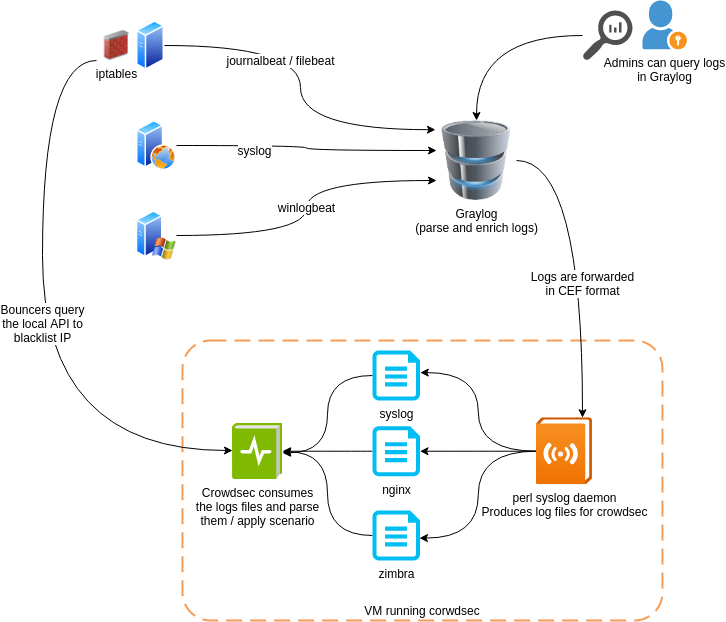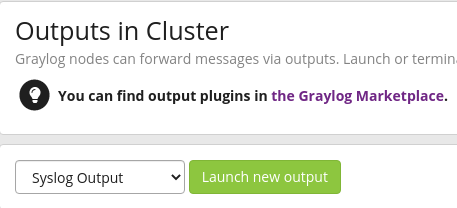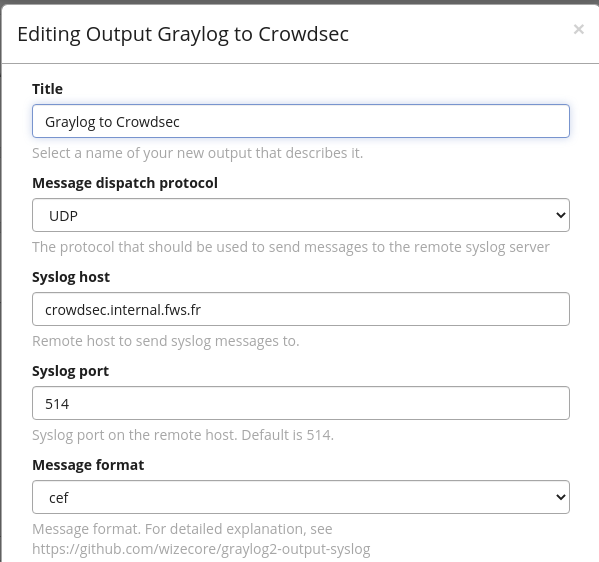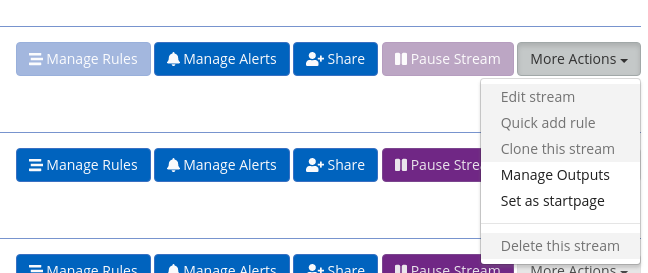Bridge Graylog and Crodwsec
Background
Crowdsec's architecture allows running several agents, each parsing the local logs on the server it's running, and sending events to a local API. While this approach works and is flexible, it might not be the most efficient. In my case, all my servers are already sending their logs to a Graylog instance. Running one crowdsec agent on all of those VM would be a waste :
- I really like the idea behind the Journal (systemd-journald), it's very conveniant. But it has a major drawback : it's slow has hell ! Better have everything on SSD, or reading the journal will slows everything down. As I already have journalbeat collecting logs from the Journal, I prefer not adding another Journal reader, which will slows things down even further
- Let's assume we have 40 VM on which we'd like crowdsec agent running. This means something like 40x80MB = 3.2GB of RAM, just for crowdsec
- I have to manage crowdsec conf on those 40 VM. Of course, ansible to the rescue, it wouldn't require manual config everywhere, but I'd still have to setup which logs to parse on which VM, which scenario to apply etc.
So, I looked for an alternative setup, and here's what I came with ![]()
Send logs from Graylog to ?
As I already have all my logs in Graylog, it'd be better to send this stream of logs to a single crowdsec installation. But, for now, crowdsec doesn't have network logs input, it can only reads files and the Journal (I've opened a ticket for this). So, the idea is to somehow forward the logs I want from Graylog to a small daemon, which would write logs for crowdsec to consume.
Here's the global flow
g2cs
I wrote a small perl daemon, named g2cs (Graylog to Crowdsec). It's available here. It'll simply listen on a UDP port, waiting for messages to consume from Graylog. It assumes the logs are sent using the CEF format (so, this is the format we'll choose later, for Graylog output). Using a structured log format between Graylog and g2cs allows some filtering in g2cs (for example, to recognize nginx log and put them in a dedicated file, separated from the general syslog). This daemon is very simple
perl g2cs.pl --port 514 --logdir /tmp/crowdsec/ --maxlines 20000
- Port is the port number g2cs will listen on
- logdir is where it'll write logs for crowdsec to consume. Inside this logdir, g2cs will create sub directories, like :
- syslog.log
- nginx
- access.log
- error.log
- httpd
- access.log
- error.log
- zimbra
- mailbox.log
- maxlines is the number of lines each file will get before being truncated. As those log files are only to feed crowdsec, the g2cs daemon will truncate them if they reach this number of lines, so they do not grow indefinitely
Configure crowdsec
Now that we have our g2cs daemon running, you can configure crowdsec acquisition to read these files. Something like
--- filenames: - /run/g2cs/logs/syslog.log labels: type: syslog --- filenames: - /run/g2cs/logs/nginx/access.log - /run/g2cs/logs/nginx/error.log labels: type: nginx --- filenames: - /run/g2cs/logs/httpd/access.log - /run/g2cs/logs/httpd/error.log labels: type: apache2 --- filenames: - /run/g2cs/logs/zimbra/mailbox.log labels: type: zimbra
Install the syslog output plugin on Graylog
OK, now that we have crowdsec and g2cs ready, we need to send our logs from Graylog to g2cs. For this, we'll use the syslog output plugin. Just download the jar from github, place it in your Graylog plugin dir (this depends on how you have installed graylog), and restart graylog-server.
Create a syslog output
Now in Graylog, you can create a new output. Go in System → Outputs. Select the “Syslog output” and click launch new output
Now, configure your Syslog output like this :
- Choose the UDP protocol
- Enter the DNS name or IP address of your server running g2cs
- Choose the port on which g2cs bind
- Choose the CEF message format
Assign output to streams
Now, you can assign in Graylog your new output to the streams you want. Go in the Stream menu, then, “Manage outputs”
And assign your Syslog output
You should now see logs flowing from Graylog, to crowdsec. I'm using this on a small graylog setup, ingesting about 400msg/sec, out of which ~200msg/sec are parsed by my single crowdsec install. I just have to install the bouncers where I want to react to all the agressive IP collected on all my servers
Run crowdsec with less privileges
Bonus point : as crowdsec only access logs from the g2cs daemon, you can run both as a less privileged user, instead of root. First, create an unprivileged user
useradd -r -s /sbin/nologin g2cs
Now adapt the systemd unit for crowdsec, eg in /etc/systemd/system/crowdsec.service.d/user.conf
Service] User=g2cs Group=g2cs
And create a systemd unit for g2cs itself, /etc/systemd/system/g2cs.service
[Unit] Description=Graylog to Crowdsec syslog daemon After=syslog.target [Service] Type=simple ExecStart=/usr/local/bin/g2cs --port=514 --logdir=/run/g2cs/logs User=g2cs Group=g2cs Restart=always PrivateTmp=yes PrivateDevices=yes ProtectSystem=full ProtectHome=yes NoNewPrivileges=yes SyslogIdentifier=g2cs # Allow binding on privileged ports CapabilityBoundingSet=CAP_NET_BIND_SERVICE AmbientCapabilities=CAP_NET_BIND_SERVICE [Install] WantedBy=multi-user.target




